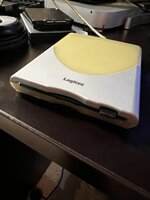We're getting to the point where having one or more bridge is more and more important. Strategizing on what those bridges are can help reduce how many of them there are and how well things work. This applies whether you're doing networking or physical media.
It was mentioned but just as a reminder, 8.6 and 9 can use HFS+ and I believe they can even format floppy diskettes that way. macOS Monterey also still speaks HFS+. Neither OS needs anything extra to get to that point.
If HFS works with a floppy drive it will with a Zip drive. Zip drives themselves work unassisted in the newest OSes and the only assistance you really need to use Floppy/Zip/MO/MD-DATA/Jaz/Orb/SyJet/literally-USB-sticks to transfer data is that both OSes involved need to speak a common filesystem.
If your systems (or one of your bridge machines) have USB, they'll be running 8.1 or newer and can use HFS+ -- just format your data transfer device with HFS+.
While you're at it -- if you have USB: you can skip Zip. USB sticks, USB pocket hard disks, and SD/CF card readers all work great under OS 9. Just format the device under 9 as HFS+ and keep it under 2TB. (Also if your Mac has USB there's a really great chance it's fast enough to just run 9.1 or 9.2.1-9.2.2.) (I know lots of people like it and we're all mostly here to huff vibes so if those are vibes you want to huff -- have at, just, you don't have to use Zip.)
Virtualization and emulation are great tools. QEMU-PPC runs Mac OS 9.2.2 remarkably well on fairly modest PC hardware. It feels/works about as fast as a G3/300 in most stuff on a CPU like the i5-2400. Low-watt/T-series desktops, laptops, and mac mini CPUs are similarly decent at it, mostly because 9 is so lightweight.
QEMU-PPC runs OS X 10.4, but poorly in my experience. Some things outright fail because lots of what OS X needs over 9, QEMU-PPC is poor at. (You'd notice this under 9 as well if you were using it for things like software development, video/3d rendering, etc)
Fortunately, on Intel-based Macs and PCs -- VMware Workstation/Player run the Intel version of 10.4 and 10.5 great and aside from a couple missing stairs for certain user-facing productivity software are a great compromise for file handling and transfer needs.
(in VMware, because QEMU networking can be weird) 10.4's built-in file server also works great for connections form any 7.1+ Mac on an '020 or better that can run the updated OpenTransport and AppleShare from 7.5 or newer. Up through Big Sur (as far as I've tested) can also connect to 10.4 file servers, so it's a good tool to have around.
(10.2/3 should do older file sharing clients, but over AppleTalk and on windows QEMU networking doesn't agree that much so I'd say reserve that for if you have a physical PPC Mac you want to run OS X on)
There's also things like A2Server and MacIPGw pi and VM images for appletalk/appleshare connectivity. I don't have those set up but they're typically based on netatalk 2 which works great.


